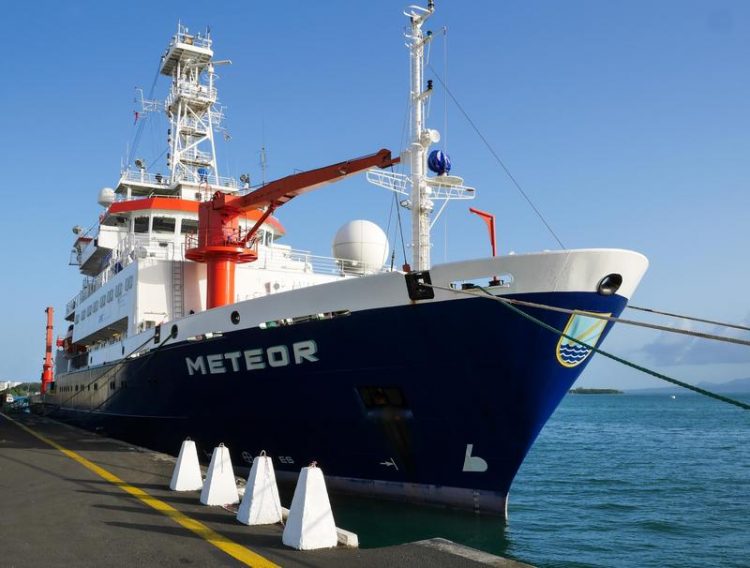Research trip to the mouth of the Amazon River: on the trail of the ocean’s material cycle

The team will travel aboard the research ship Meteor. Photo: Martin Visbeck / GEOMAR
The Amazon River is almost 7,000 km long and is not only tremendously abundant but it also transports large quantities of trace metals such as iron and copper and dissolved organic materials. It is these materials that interest the team comprising Andrea Koschinsky, Prof. Thorsten Dittmar from the University of Oldenburg and Prof. Martin Frank from GEOMAR – Helmholtz Centre for Ocean Research Kiel as well as the four Brazilian partner organizations.
“We want to gain a better understanding of the material cycle in the ocean,” says Andrea Koschinsky about the M 147 research trip’s aims. “We will only be able to reliably predict the human impact on this cycle if we succeed in this”. Trace elements such as carbon, nitrogen and phosphorus play an important role in the ocean as they are essential elements for the formation of biomass. However, all life needs iron – even the smallest marine organism requires it.
The Amazon River carries many elements into the sea, including iron. Part of the elements flocculate when the freshwater meets the salt water and mixes, they drop down and settle on the bottom of the river mouth as sediment.
However, another part remains in the water and forms part of the material cycle in the ocean. On their research trip, the scientists want to find out exactly how these processes work, their interdependencies, interactions and quantities. Their focus is on the flow of iron as well as other important trace elements and organic molecules.
The scientists will take the first water samples from the river where the freshwater is the purest. The ship will then follow the course of the river via the brackish salt water and freshwater water system until its keel reaches the pure seawater. Sediment samples will taken from the seabed, from the river at a depth of up to 100 m and from the sea at a depth of up to 2,000 m.
The findings will also be used to record and understand disruptions to natural geochemical and biological process in the marine environment caused by people. Humans are intervening in the fragile ecosystem of the Amazon and changing it significantly in particular by building dams, deforestation and intensive agriculture.
The joint project financed by the German Research Foundation (DFG) is part of the international GEOTRACES program. Its aim is to record the distribution of trace elements and isotopes in the ocean and to understand the processes that control this distribution. The data collected will, among other things, contribute to a better understanding of the effects of climate change on the oceans.
More information:
http://akoschinsk.user.jacobs-university.de/
Questions will be answered by:
Prof. Dr. Andrea Koschinsky | Professor of Geosciences
a.koschinsky@jacobs-university.de | Tel: +49 421 200-3567
About Jacobs University:
Jacobs University is a private, independent, English-medium university in Bremen. Young people from all over the world study here in preparatory, Bachelor, Master, and PhD programs. Internationality and transdisciplinarity are special features of Jacobs University: research and teaching don’t just pursue a single approach, they address issues from the perspectives of multiple disciplines. This principle makes Jacobs graduates highly sought-after new talents who successfully strike out on international career paths.
More information: www.jacobs-university.de
Contact:
Thomas Joppig | Brand Management, Marketing & Communications
t.joppig@jacobs-university.de | Tel.: +49 421 200-4504
Media Contact
All latest news from the category: Earth Sciences
Earth Sciences (also referred to as Geosciences), which deals with basic issues surrounding our planet, plays a vital role in the area of energy and raw materials supply.
Earth Sciences comprises subjects such as geology, geography, geological informatics, paleontology, mineralogy, petrography, crystallography, geophysics, geodesy, glaciology, cartography, photogrammetry, meteorology and seismology, early-warning systems, earthquake research and polar research.
Newest articles

First-of-its-kind study uses remote sensing to monitor plastic debris in rivers and lakes
Remote sensing creates a cost-effective solution to monitoring plastic pollution. A first-of-its-kind study from researchers at the University of Minnesota Twin Cities shows how remote sensing can help monitor and…

Laser-based artificial neuron mimics nerve cell functions at lightning speed
With a processing speed a billion times faster than nature, chip-based laser neuron could help advance AI tasks such as pattern recognition and sequence prediction. Researchers have developed a laser-based…

Optimising the processing of plastic waste
Just one look in the yellow bin reveals a colourful jumble of different types of plastic. However, the purer and more uniform plastic waste is, the easier it is to…



